The temperatures on Mount Kilimanjaro range from hot to bitter cold.
Climbing Kilimanjaro is unique for many reasons, and one of these is that from origin to summit, climbers find themselves weaving through several distinct climate zones. It is said that the journey from the gate to the peak is like traveling from the equator to Antarctica in a matter of days!
Mount Kilimanjaro has five major ecological zones, each approximately 3,280 feet (1,000 m) in altitude. Each zone is subject to a corresponding decrease in rainfall, temperature and flora/fauna as the altitude increases.
Weather in Moshi
Moshi, the gateway town from which our climbs are organized, is located just south of the base of Mount Kilimanjaro. At 2,667 feet (900 m) above sea level, the town is located in the lowest, warmest ecological zone. Average temperature, humidity and precipitation figures for Moshi are reflected in the following table.
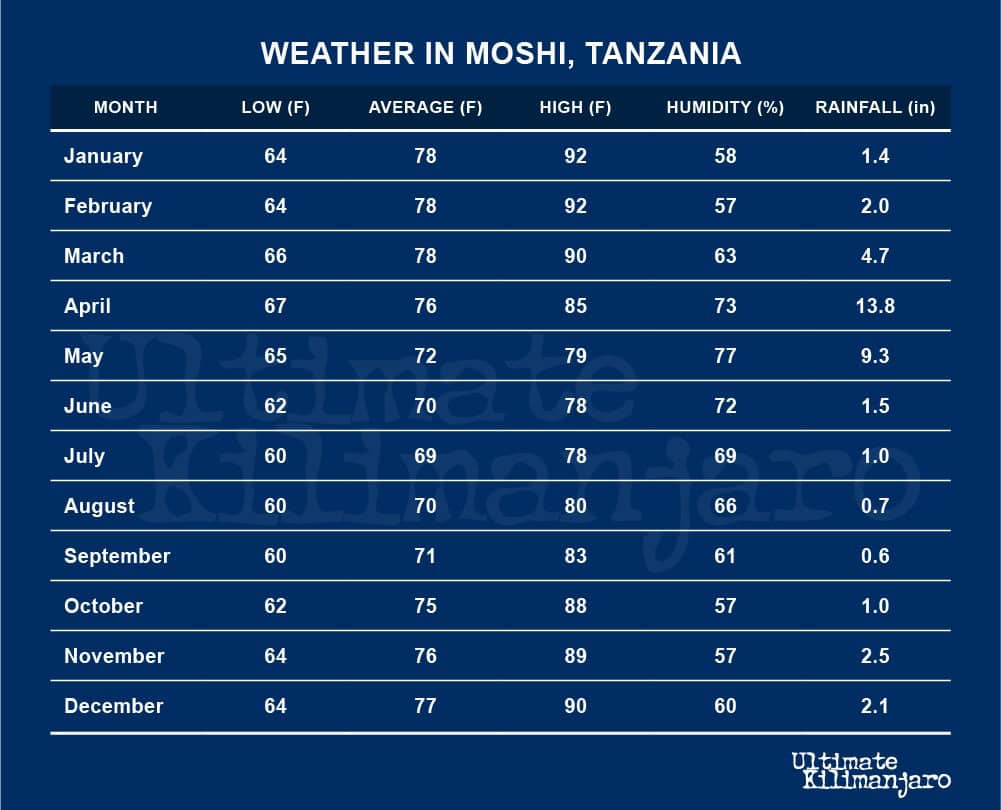
As shown, January and February are the warmest months, April and May are the wettest months, June and July are the coolest months, and August and September are the driest months. These generalities about the weather in Moshi hold true for Mount Kilimanjaro as well.
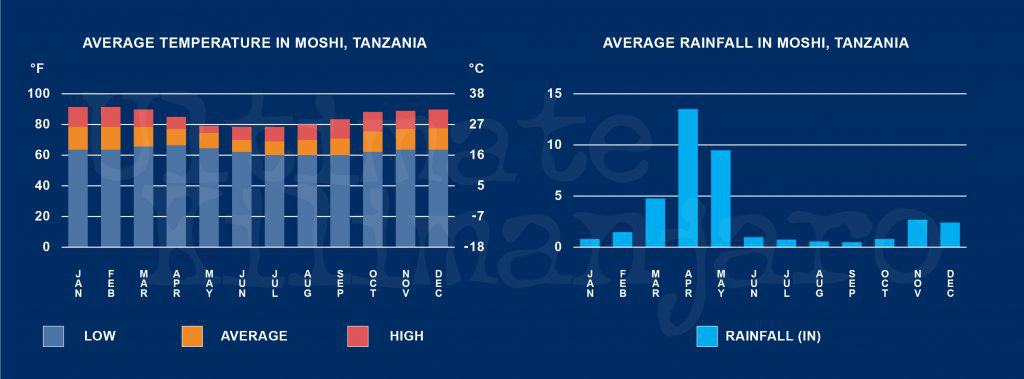
Weather Overview on Mount Kilimanjaro
Due to its proximity to the equator, Mount Kilimanjaro does not experience wide temperature changes from season to season. Instead, the temperatures on Mount Kilimanjaro are determined more so by the altitude and time of day.
At the beginning of the climb, at the base of the mountain, the average temperature is around 70 to 80 degrees Fahrenheit (21 to 27 degrees Celsius). From there, the temperatures will decrease as you move through Mount Kilimanjaro’s ecological zones.
At the summit, Uhuru Point, the night time temperatures can range between 20 and -20 degrees Fahrenheit (-7 to -29 degrees Celsius). Due to Mount Kilimanjaro’s great height, the mountain creates its own weather. It is extremely variable and impossible to predict. Therefore, regardless of when you climb, you should always be prepared for wet days and cold nights.
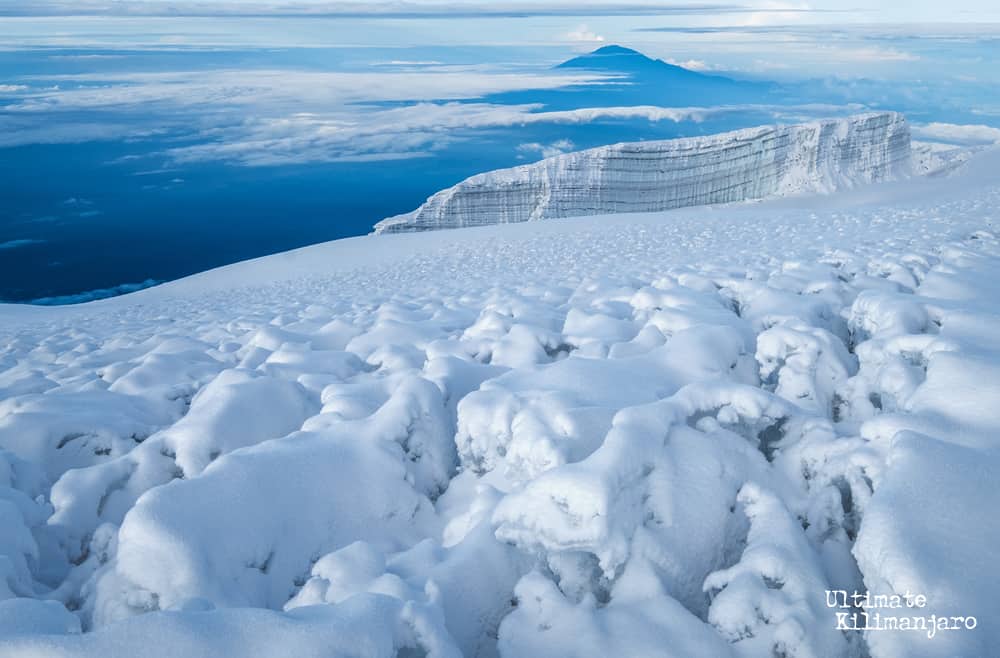
Kilimanjaro’s Five Ecological Zones
Mount Kilimanjaro presents an ecological tour across five distinct zones, each with unique characteristics and flora and fauna.
An ecological zone, often referred to as a biome or ecoregion, is a specific geographic area notable for its relatively uniform climate, soil, and altitude. These factors collectively determine the types of life forms that can thrive in that area. These zones are natural divisions of the Earth’s landscapes, defined by both abiotic (non-living) and biotic (living) factors.
Bushland/Cultivated Zone (2,600 to 6,000 ft / 792 to 1,828 m)
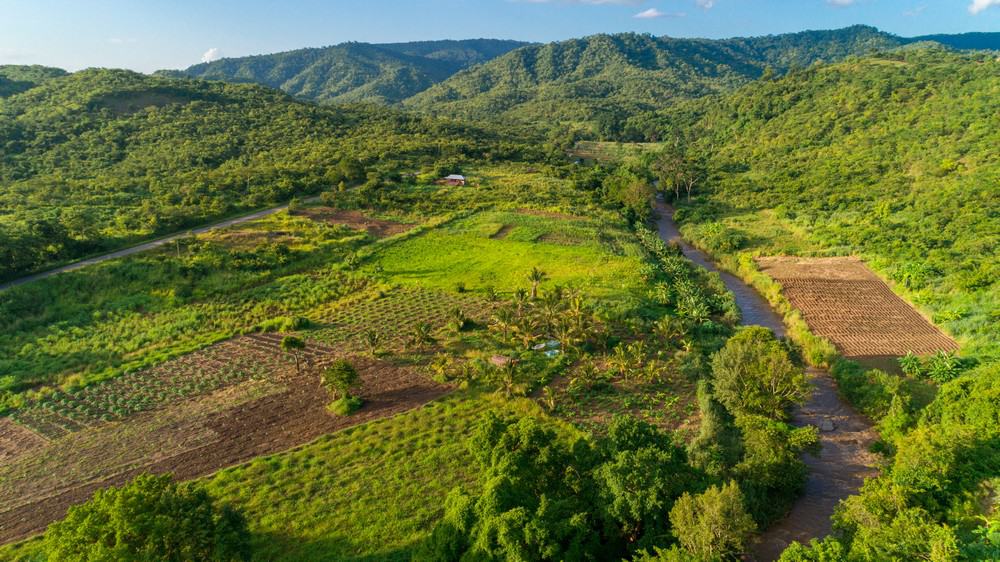
This zone is characterized by human settlements and fertile agricultural lands that are ideal for growing crops like coffee and tropical fruits. It is also home to small nocturnal mammals and various bird species.
Rainforest Zone (6,000 to 9,200 ft / 1,828 to 2,804 m)
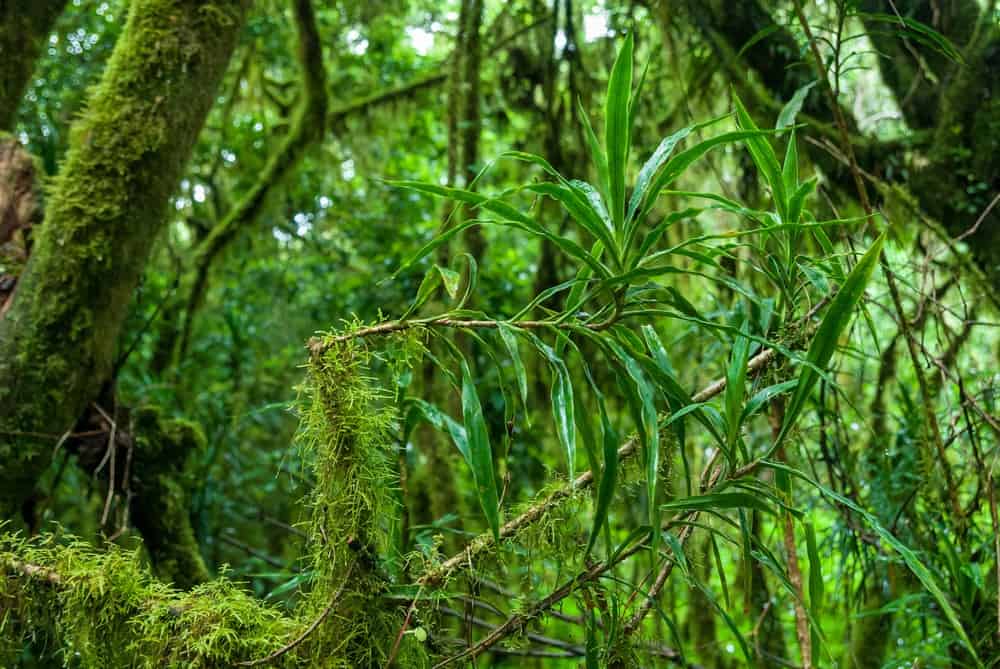
Known for its rich biodiversity, this zone features dense forests and receives abundant rainfall. It supports a wide array of wildlife, including monkeys and a diverse bird population.
Heath/Moorland Zone (9,200 to 13,200 ft / 2,804 to 4,023 m)
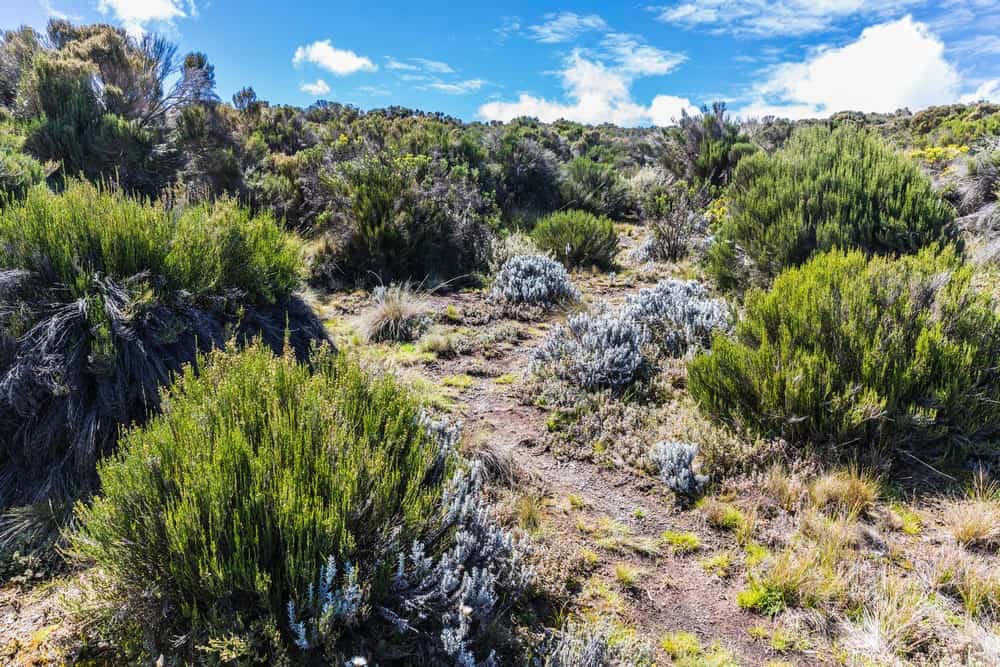
This area is covered in heath-like vegetation and wildflowers. Climbers often begin to feel the effects of altitude sickness in this zone. The landscape is dominated by unique plants such as Senecios and Giant Lobelias.
Alpine Desert Zone (13,200 to 16,500 ft / 4,023 to 5,029 m)
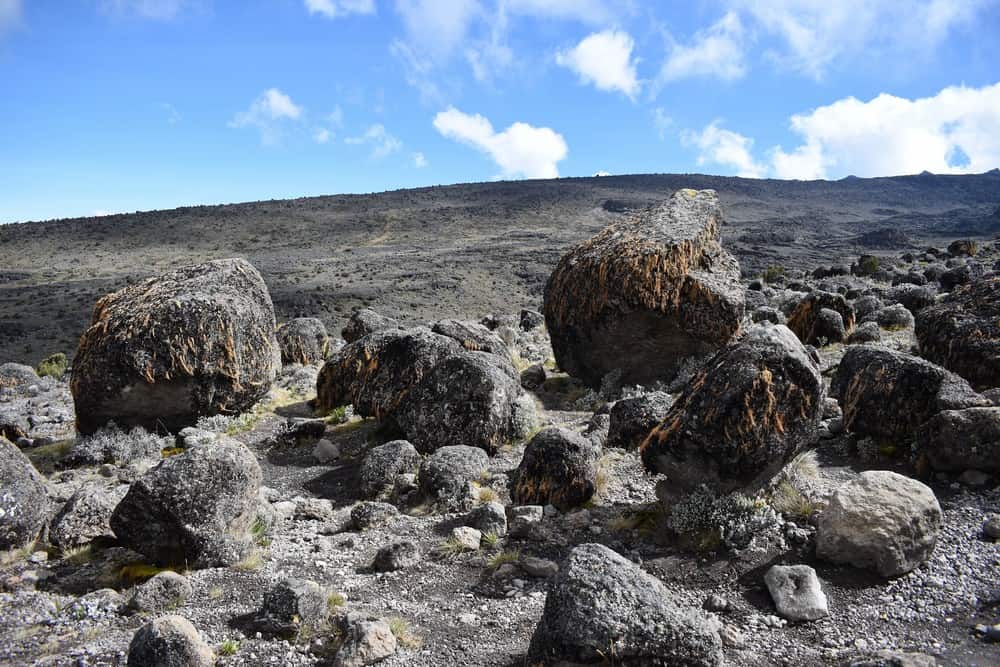
Receiving little precipitation, this zone is marked by extreme temperature changes and sparse vegetation. It’s a critical area for climbers to acclimatize before attempting the summit, with limited wildlife sightings.
Arctic Zone (above 16,500 ft / 5,029 m)
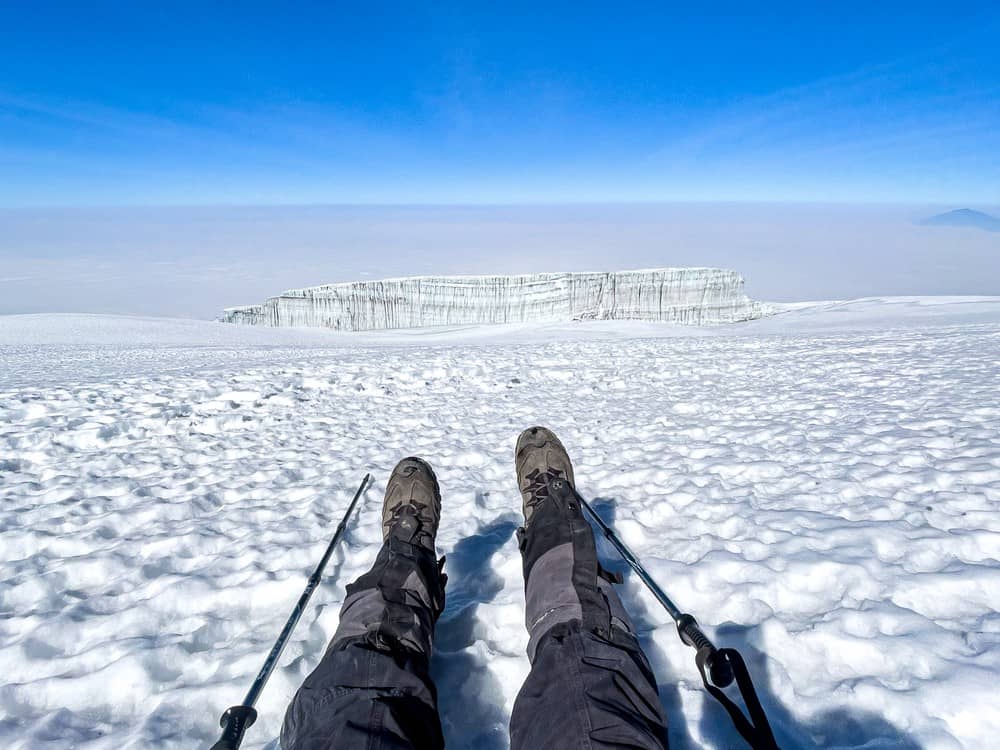
The summit zone resembles an Arctic environment, with minimal flora and fauna due to the severe conditions. Climbers in this zone face extreme altitude challenges, with oxygen levels significantly lower than at sea level.
Kilimanjaro Weather by Month and Zone
Mount Kilimanjaro’s weather varies significantly across its ecological zones and seasons. It’s essential to prepare for a wide range of conditions as the weather is unpredictable.
NOTE: The temperatures listed below are averages. The temperature you experience may be drastically different than the figures presented.
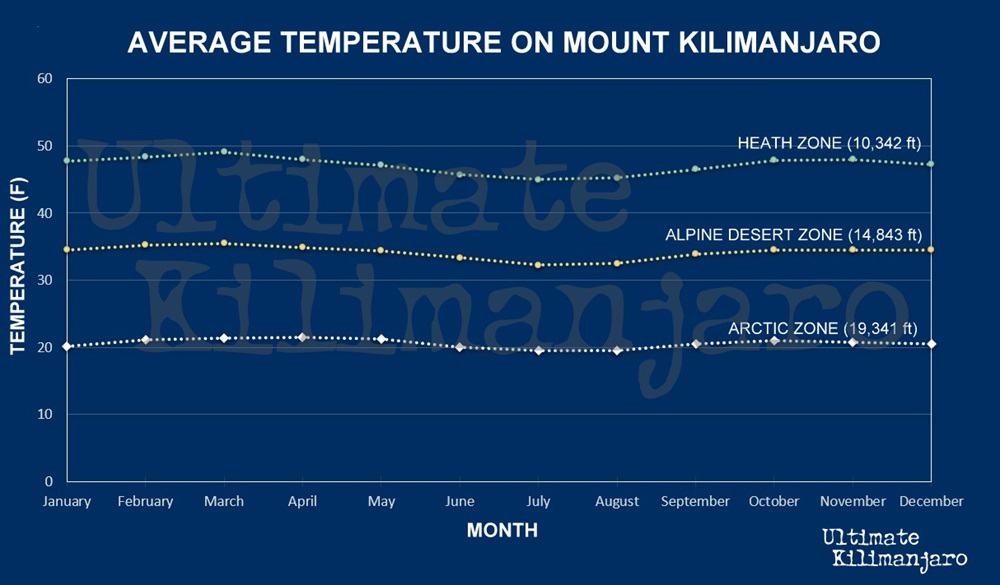
December to February
These months are part of Kilimanjaro’s shorter dry season, offering clear skies and warmer temperatures, ideal for climbing. Recommended for climbing.
- Bushland/Cultivated Zone: Warm with occasional rain showers.
- Rainforest Zone: Humid and wet, though less rain than in the wet season.
- Heath/Moorland Zone: Cool and dry, with clear visibility.
- Alpine Desert Zone: Daytime warmth with chilly nights.
- Arctic Zone: Cold, with a lower chance of snowfall.
March to May
This period is Kilimanjaro’s long rainy season. Trails can be slippery and challenging. Generally not recommended for climbing.
- Bushland/Cultivated Zone: Heavy rainfall, making paths muddy.
- Rainforest Zone: Frequent and heavy downpours.
- Heath/Moorland Zone: Misty, with rain and cooler temperatures.
- Alpine Desert Zone: Occasional snowfall and colder nights.
- Arctic Zone: Higher likelihood of snow, with colder conditions.
June to August
The first half of the dry season, with colder temperatures but generally clear days. Recommended for climbing.
- Bushland/Cultivated Zone: Cooler and drier.
- Rainforest Zone: Dampness lingers, but less rainfall.
- Heath/Moorland Zone: Cold, especially at night, with less precipitation.
- Alpine Desert Zone: Dry but cold, with freezing nights.
- Arctic Zone: Very cold, especially at night, with occasional snow.
September to October
Continuation of the dry season. Good climbing conditions with colder temperatures at higher altitudes. Recommended for climbing.
- Bushland/Cultivated Zone: Mild and dry.
- Rainforest Zone: Decreasing humidity and rain.
- Heath/Moorland Zone: Cold nights, but generally dry.
- Alpine Desert Zone: Extremely cold nights.
- Arctic Zone: Very cold, particularly at night, with a chance of snow.
November
Short rainy season, with afternoons and evenings experiencing showers. Generally not recommended for climbing.
- Bushland/Cultivated Zone: Intermittent rain, mostly in the afternoons.
- Rainforest Zone: Regular rainfall, especially in the afternoons.
- Heath/Moorland Zone: Wet and misty conditions return.
- Alpine Desert Zone: Occasional snow showers and colder temperatures.
- Arctic Zone: Cold with a higher probability of snow.
This short film presents the beauty of Kilimanjaro’s ecological zones in breathtaking fashion.
Final Word
As you can see, on Mount Kilimanjaro, you have to be prepared for a wide range of weather conditions – from hot and humid to cold and windy. You also have to be prepared for the strong sun, rain and even possibly a blizzard (very rare).
In general, the higher you climb, the colder it gets, and the drier it gets. For most routes, you’ll spend very little time in the arctic zone and a short amount of time in the rainforest zone. The bulk of your days and nights will be in the heath zone and alpine desert.
Usually, the conditions here are fairly comfortable. During the day hikes, most people wear just one or two layers on top, such as a baselayer alone or a baselayer plus a softshell jacket. At night, while at camp, people wear their warmer layers – such as their down jacket with fleece pants.
More often than not, if you climb during the dry seasons, the weather you’ll experience should be pleasant – that means dry and sunny with mild temperatures. So don’t be intimidated by the weather. When you have the right gear, you will have everything you need to stay warm and dry even in the worst conditions.



















































